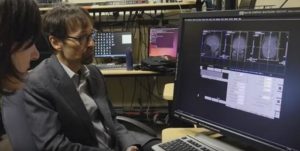
VIDEO 3:10: How semantic brain mapping works
In the following short video, you will see some of the results of semantic brain mapping research. The video briefly discusses how scientists, using big data concepts to map data sets in the brain, have mapped brain activity patterns as a person listens to a story. The brain has been segmented into areas active at each part of the story, differentiating areas that appreciate material properties of objects from social concepts. It is estimated that there are 200-400 modules spread around the brain, and of those, about 100-150 are doing language processing.
The result is potentially enabling scientists to build a mathematical model or decoder to see how brain extracts meaning. It is anticipated such brain mapping will help stroke patients recover language skills, using brain-machine interfaces such as are the subject of development at several universities.
To see a video demonstrating brain semantic mapping further, as seen in the featured image above by Nature.com, visit the next page.



